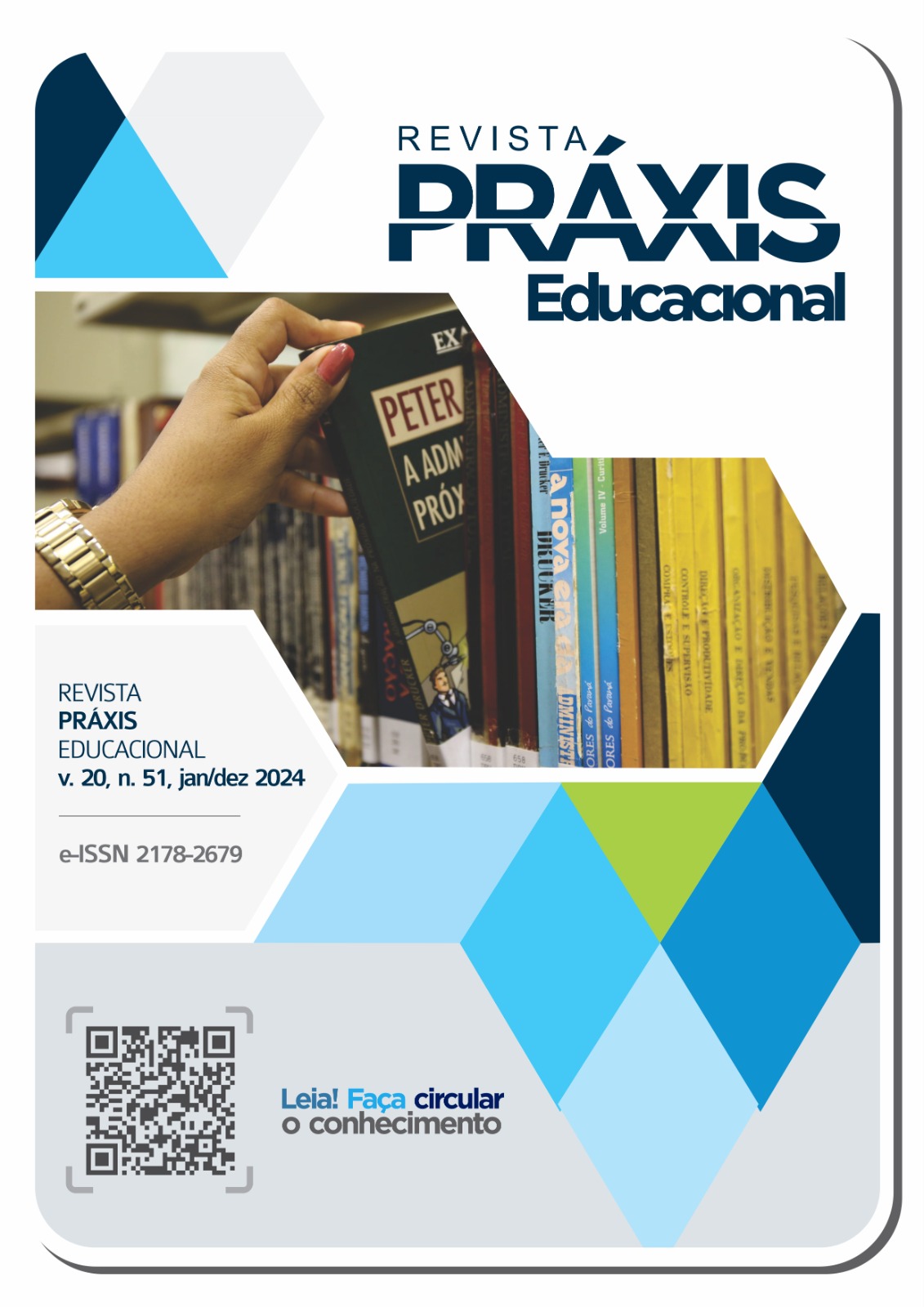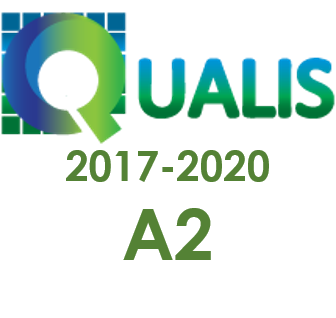Cell phones, teachers and students: challenges for the elaboration of another pedagogical contract
DOI:
https://doi.org/10.22481/praxisedu.v20i51.12214Keywords:
smartphone, teacher, high school, Critical Theory of SocietyAbstract
In the so-called digital culture society, cell phones are so widespread that, on many occasions, they are identified by people as if they were part of their own body. Evidently, the school environment is identified as a space where such devices become omnipresent, to the point of prompting reflection on how they could be used pedagogically. In view of this, the objective of the authors of this article is to critically reflect on the role of the high school teacher in the face of the increasingly frequent use of cell phones inside and outside the classroom for supposedly pedagogical purposes. Relying on thinkers from the Critical Theory of Society, the methodology used was the analysis of 17 academic articles published in recent years, which examined the contribution of cell phones in high school classes. From this, it was possible to conclude that, if the cell phone can be used pedagogically, as well as engender practices of concentration dispersion and cyberbullying, it is essential to encourage the presence of pedagogical contracts between educational agents so that they can mutually agree on when and how to use such a device during activities carried out in classrooms.
Downloads
Metrics
References
ADORNO, Theodor W. Teoria da semiformação. Tradução: Newton Ramos-de-Oliveira. In: PUCCI, Bruno; ZUIN, Antônio A. Soares; LASTÓRIA, Luiz Antônio. Calmon Nabuco (org.). Teoria crítica e inconformismo: novas perspectivas de pesquisa. Campinas: Autores Associados. 2010. p. 7-40.
ARAÚJO, Jussara da Silva Nascimento; ARAÚJO, Franklyn Kenny dos Santos. Multiletramento no ensino da língua inglesa em sala de aula para o ensino médio. In: VASCONCELOS, Adaylson Wagner de; VASCONCELOS, Thamires Nayara Sousa de (org.). Educação e tecnologias: experiências, desafios e perspectivas, vol.4, São Paulo: Atena, 2019. p.48-80. Disponível em: https://www.atenaeditora.com.br/catalogo/post/multiletramento-no-ensino-da-lingua-inglesa-em-sala-de-aula-para-o-ensino-medio. Acesso em: 25 fev.2021.
BARBOSA, Cairo Dias; GOMES, Luiz Moreira; CHAGAS, Maria Liduína das; FERREIRA, Fernanda C. Lima. O uso de simuladores via smartphone no ensino de física: O experimento de Oersted. Scientia Plena, vol.13, n.01, p.1-13, 2017.Disponível em: https://www.scientiaplena.org.br/sp/article/view/3358/.1644 Acesso em:17 fev.2021.
BITENCOURT, Dariane de Castro; REIS, Susana Cristina. Integração de dispositivos móveis em aulas de língua portuguesa: uma proposta de gestão pedagógica para uso nas escolas. Revista Novas Tecnologias na Educação, Porto Alegre, vol. 18, n. 1, 2020. Disponível em: https://seer.ufrgs.br/index.php/renote/article/view/105986. Acesso em: 25 fev.2021.
CAMPBELL, Scott. Perceptions of mobile phones in college classrooms: ringing, cheating, and classroom policies. Communication Education, vol. 55, n. 3, p. 280-294, 2006.
CASTRO, Camila Sandim; RODRIGUES, Luciana Azevedo. Disciplina e indisciplina escolar em tempos de sociedade excitada. Impulso, Piracicaba, vol.26, n.67, p.23-37, 2016. Disponível em: www.metodista.br/revistas/revistasunimep/index.php/impulso/article/view/2607/1913. Acesso em: 15 ago. 2021.
FARIAS, Márcio Norberto. Vício pelas telas digitais: Contribuições do pensamento de Christoph Türcke para a educação corporal. Problemata, vol. 9, n. 1, p. 159-178, 2018. Disponível em: https://periodicos.ufpb.br/ojs/index.php/problemata/article/view/38718/19998. Acesso em: 20 set. 2021.
FORTUNATI, Leopoldina. The mobile phone as technological artefact. In: GLOTZ, Peter; BERTSCHI, Stefan.; LOCKE, Chris (org.). Thumb culture: the meaning of mobile phones for society. Bielefeld: Transcript Verlag, p.149-160, 2005.
FREITAS, Neliane Alves. MARTINHO, Ítalo, Weyder Teles; SANTOS, Marcos Paulo Nascimento; NETO Olavo Nylander Brito. Prática pedagógica com celular e Stop-Motion em interdisciplinaridade com Artes. In: WORKSHOP DE INFORMÁTICA NA ESCOLA (WIE), 22., 2016, Uberlândia. Anais [...]. Porto Alegre: Sociedade Brasileira de Computação, p. 953-957, 2016.Disponível em: https://sol.sbc.org.br/index.php/wie/article/view/16494/16335 Acesso em: 18 fev. 2021.
GRÖHS, Décio de Oliveira; MELO, José Ronaldo. A utilização do aplicativo desmos como aporte tecnológico nas aulas de matemática financeira: uma experiência com alunos do ensino médio. Série educar: Matemática, Tecnologia, Engenharia, vol.35,1ª ed., Belo Horizonte: Poisson, 2020. p.95-101. Disponível em: https://www.poisson.com.br/livros/serie_educar/volume35/Educar_vol35.pdf. Acesso em:15 mar. 2021.
HURTADO, Antônio Paulo Guillen; HURTADO, Karine de Paula Ramos; COSTA, Priscila Caroza Frasson. O uso do smartphone como recurso pedagógico na disciplina de sociologia na EJA. Diálogo, Canoas, n. 43, p. 99-106, 2020. Disponível em: https://revistas3.unilasalle.edu.br/index.php/Dialogo/article/view/5082/pdf . Acesso em:18 fev. 2021.
KHATCHADOURIAN, Luana de França Perondi. O smartphone na sala de aula de língua inglesa: integrando artefato e tarefas pela abordagem da teoria ator-rede. In: Diálogos Pertinentes. vol. 16, n. 2, p. 195-215, 2020. Disponível em: https://publicacoes.unifran.br/index.php/dialogospertinentes/article/view/3322. Acesso em : 03 mar. 2021.
KOPECKY, Kamil.; SZOTKOWSKI, René. Cyberbullying, cyber aggression and their impact on the victim: The teacher. Telematics and Informatics, vol. 34, p. 506-517, 2017. DOI: 10.1016/j.tele.2016.08.014
LOMBARDI, Evandro; GITAHY, Raquel Rosan Christino. O uso das tecnologias móveis na educação: uma experiência com o ed puzzle. Colloquium Humanarum, vol. 14, n. especial, p. 590-594, 2017. Disponível em: https://docplayer.com.br/141525120-O-uso-das-tecnologias-moveis-na-educacao-uma-experiencia-com-o-ed-puzzle.html pdf. Acesso em: 17 fev.2021.
MAGUTH, Brad. The educative potential of cell phones in the social studies classroom. Social Studies, vol. 104, n. 2, p. 87-91, 2013.
MANHÃES, Marcelle de Oliveira; BATISTA, Silvia Cristina Freitas; MARCELINO, Valéria de Souza. Sequência didática para o ensino de Anatomia Humana: proposta com metodologia ativa associada ao uso do smartphone. REnCiMa, São Paulo, vol. 11, n. 6, p. 877-897, 2020. Disponível em: https://revistapos.cruzeirodosul.edu.br/index.php/rencima/article/view/2638/1458 . Acesso: 26 fev.2021.
MARCUSE, Herbert. Tecnologia, guerra e fascismo. São Paulo: Editora da Unesp, 1999.
NASCIMENTO, Ayrton Matheus da Silva; ARAÚJO, Natalia Kelly da Silva; LIMA, Jaqueline Costa da Silva; NERI, Patrícia Hander de Lucema. Uso de tecnologia informação e comunicação (tic’s) nas aulas de química no conteúdo de isomeria geométrica (estereoisomeria). IJET-PDVL, Recife, vol.2, n.2, p. 15 - 29, 2019. Disponível em: https://ijet-pdvl.com/index.php/pdvl/article/view/73/358.Acesso em: 06 mar.2021.
PEREIRA, Jaqueline da Silva. Do consumo as apropriações: o uso de smartphones por estudantes do ensino médio em Cuiabá. Revista Anagrama, vol. 10, n. 1, p.1-19, 2016. Disponível em: https://www.revistas.usp.br/anagrama/article/view/108978/107451. Acesso em: 23 jan. 2021
PEREIRA, Joselene Tavares Lima; FERREIRA, Simone de Lucena. O smartphone e a produção de memes como dispositivos de aprendizagem. In: REUNIÃO NACIONAL DA ANPED, 39., Niterói, 2019. GT16: Educação e Comunicação. Niterói: Universidade Federal Fluminense, 2019. p.1-8. Disponível em: http://39.reuniao.anped.org.br/wp-content/uploads/sites/3/trabalhos/5209-TEXTO_PROPOSTA_COMPLETO.pdf Acesso em: 23 fev.2021.
RAMOS, Márcia Elisa. Teté; JUNIOR, Arnaldo Martin Szlachta. O smartphone e o uso do game pokémon go nas aulas de história. In: CONGRESSO INTERNACIONAL DE HISTÓRIA, 8.; SEMANA DE HISTÓRIA, 22., Maringá, 2017. Anais [...]. Maringá: Universidade Estadual de Maringá, 2017. p.3055-3063. Disponível em: http://www.cih.uem.br/anais/2017/trabalhos/3508.pdf . Acesso em : 07 mar. 2021.
REDDY, Linda; REYNOLDS, Cecil. Understanding and preventing violence directed against teachers: Recommendations for a National Research Practice, and Policy Agenda American. American Psychologist, vol. 68, n. 2, p. 75-87, 2013.
RICHARDSON, Jonh. Powerful devices: how teens’ smartphones disrupt power in the theatre, classroom and beyond. Learning, Media and Technology, vol. 1, p. 1-18, 2013.
SANTOS, Antônio José Costa; OLIVEIRA, Vilma Bragas. O uso do celular em escolas do ensino médio: panorama e direcionamentos. Revista Eletrônica Científica Ensino Interdisciplinar, Mossoró, vol. 6, n. 18, p.679-695, 2020.Disponível: https://periodicos.apps.uern.br/index.php/RECEI/article/view/2150/2488. Acesso em: 07 mar. 2021.
SILVA, Denis; DIAS, Raquel; FLIPPERT, Vania de Fatima T.; BOSCARIOLI, Clodis. Usando Smartphones, QR Code e Game of Thrones para Gamificar o Ensino e Aprendizagem de Termometria. In: WORKSHOP DE INFORMÁTICA NA ESCOLA, 23., 2017, Recife. Anais [...]. Porto Alegre: Sociedade Brasileira de Computação, 2017. p. 658-666. Disponível em: https://sol.sbc.org.br/index.php/wie/article/view/16301/16142. Acesso em : 15 mar. 2021.
SILVA, Leydiane Trindade; ARAÚJO, Sulene Alves; LIMA, Alba C. Menezes; ROCA, Marcelo Eça. Análise e uso de aplicativos móveis no processo ensino aprendizagem da Tabela Periódica. Braz. J. of Develop, Curitiba, vol. 6, n. 9, p. 67056-67073, 2020. Diponível em: https://ojs.brazilianjournals.com.br/ojs/index.php/BRJD/article/view/16408/13422 . Acesso em: 18 mar. 2021.
STEINERT, Monica Érika Pardin; HARDOIM, Edna Lopes. Leigos ou excluídos? A criação de um aplicativo educacional e seu uso via ensino híbrido em uma escola pública. Revista SUSTINERE, Rio de Janeiro, vol. 5, n. 1, p. 90-113, 2017. Disponível em: https://www.e-publicacoes.uerj.br/sustinere/article/view/25067/21305. Acesso em: 21 fev. 2021.
TÜRCKE, Christoph. Sociedade Excitada: filosofia da sensação. Tradução: Antônio Álvaro. Soares. Zuin, Fabio Durão, Francisco Fontanella e Mario Frungillo. Campinas: Editora da Unicamp, 2010.
VILELA, Rita Amelia Teixeira. O domínio dos mecanismos da indústria cultural na sala de aula e o bloqueio da experiência formativa. In: MAIA, Ari Fernando; ZUIN, Antônio Álvaro Soares; LASTÓRIA, Luiz Antônio Calmon Nabuco (org.). Teoria crítica da cultura digital: aspectos educacionais e psicológicos, 1ª ed., São Paulo: NANKIN, p.93-108, 2015.
VILELA, Jean Louis Landim; FERRAZ, Anderson Claiton; ARAUJO, Mauro Sérgio Teixeira. Utilização de um aplicativo de smartphone no ensino de física. In. SILVA, Américo Junior Nunes da(org.). Educação: atualidade e capacidade de transformação do conhecimento gerado. Paraná: Atena, p.230-239, 2020. Disponível em: https://www.atenaeditora.com.br/catalogo/post/utilizacao-de-um-aplicativo-de-smartphone-no-ensino-de-fisica Acesso em: 28 de mar.2021
ZUIN, Antônio Álvaro. Soares. Cyberbullying contra professores: dilemas da autoridade dos educadores na era da concentração dispersa. São Paulo: edições Loyola,2017.
ZUIN, Antônio Álvaro. Soares; ZUIN, Vânia Gomes. Lembrar para elaborar: reflexões sobre a alfabetização crítica da mídia digital. Pro-Posições, Campinas, vol.28, n.1, p.213-234, 2017. Disponível em: https://www.scielo.br/j/pp/a/WG7H55KHT8QvRWffdYN43Gv/?format=pdf&lang=pt. Acesso em : 24 abr. 2021.
ZUIN, Antônio Álvaro Soares; ZUIN, Vânia Gomes. A autoridade do professor no contexto da autoridade algorítmica digital. In: Pro-Posições, Campinas, vol. 30, p.1-24, 2019. Disponível em: https://www.scielo.br/j/pp/a/HzDxP43QKgHfxkVyqhWfVmx/?format=pdf&lang=pt. Acesso: 19 jan. 2021.
Downloads
Published
How to Cite
Issue
Section
License
Copyright (c) 2024 Práxis Educacional

This work is licensed under a Creative Commons Attribution 4.0 International License.
You are free to:
Share - copy and redistribute the material in any medium or format; Adapt - remix, transform, and build from the material for any purpose, even commercially. This license is acceptable for Free Cultural Works. The licensor cannot revoke these freedoms as long as you follow the terms of the license.
Under the following terms:
Attribution - You must appropriately give credit, provide a link to the license, and indicate if any changes have been made. You may do so in any reasonable way, but not in a way that suggests that you or your use is endorsed by the licensor.
There are no additional restrictions - You cannot apply legal terms or technological measures that legally restrict others to make any use permitted by the license.










